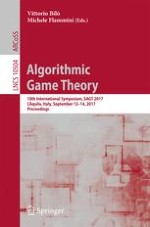2017 | OriginalPaper | Buchkapitel
Conditional Value-at-Risk: Structure and Complexity of Equilibria
verfasst von : Marios Mavronicolas, Burkhard Monien
Erschienen in: Algorithmic Game Theory
Aktivieren Sie unsere intelligente Suche, um passende Fachinhalte oder Patente zu finden.
Wählen Sie Textabschnitte aus um mit Künstlicher Intelligenz passenden Patente zu finden. powered by
Markieren Sie Textabschnitte, um KI-gestützt weitere passende Inhalte zu finden. powered by
